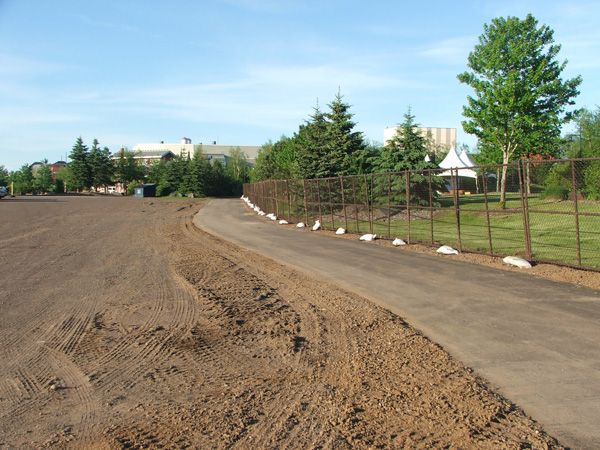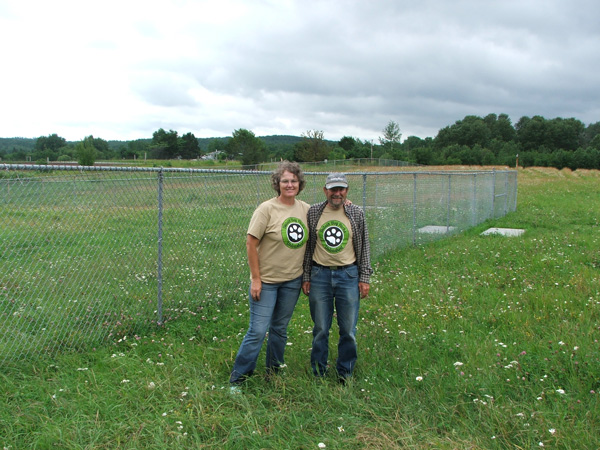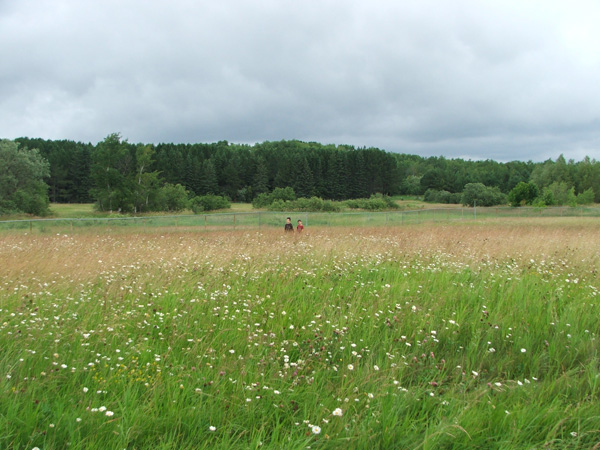Park notes

New Bayfront path
If you’ve visited Bayfront Festival Park recently, you may have noticed a new paved path running along two sides of it—the side facing the large gravel parking lot off Railroad Street and the side facing the aquarium. The path is part of the city’s arrangement with the developers of the Pier B hotel, which recently opened for business on the other side of Slip 2, just west of Bayfront.
As part of their project, Pier B restored and rebuilt the crumbling seawalls of Slip 2. On the west side of the slip, they rebuilt docking facilities to allow private boats to tie up at the hotel. On the Bayfront side of the slip, where work is continuing, the wall is being restored with stone riprap and sheet piling. A sliding bridge at the head of the slip will connect the hotel to Bayfront. A concern, however, was that the bridge would also allow people to wander behind the main stage while concerts were going on at Bayfront. The new path will enable visitors who cross the sliding bridge to walk around Bayfront during concerts, maintaining a connection to the rest of the waterfront and Canal Park.
The two legs of the path that have been completed were built by city crews earlier this summer. The third and final leg, along the edge of the slip, is not yet built. Pier B will build it when they have completed their seawall work. They will be reimbursed up to $1 million by the Duluth Economic Development Authority for the path and the seawall work. According to Heidi Timm-Bijold, the city’s business resources manager, “Given that the Pier B-funded project included similar work [on their side of the slip], it was most logical to have their contractors secure the permits and design/construct the City infrastructure as well, and to then reimburse them for the City infrastructure.” The $1 million consists of tax-increment financing money that DEDA set aside for that purpose in 2014.
The new path is currently separated from Bayfront by temporary fencing, which the city will eventually replace with a permanent, decorative wrought-iron fence. Timm-Bijold said that work on the seawall and the final leg of the new path should wrap up in two to three weeks.
More money for Spirit Mountain
On July 18, 2016, the city council committed more resources to the Spirit Mountain Recreation Area when they approved a $66,000 contract with Ecosign, a Canadian company that bills itself as “a world leader in creative design solutions for mountain resorts,” to develop an updated master plan for Spirit Mountain.
Ecosign is no stranger to the ski hill. In 2007, Spirit Mountain’s then-executive director Renee Mattson hired Ecosign to develop the initial master plan that was intended to make Spirit Mountain more “self-sustaining.” “We are not asking Duluthians for a penny,” Mattson assured reporters at the time. Many of the recommendations in that plan have since been fulfilled—a new chalet, an alpine coaster, updated ski lifts, a mountain bike terrain park, and more. As I have often pointed out, these improvements were a big factor in contributing to Spirit Mountain’s present-day financial difficulties—the ski hill squandered its capital maintenance budget to build them even as the improvements themselves added to the ski hill’s capital maintenance needs. Today, the city is paying for ALL the improvements, as well as giving Spirit Mountain a $250,000 annual operating subsidy and a $1.2 million interest-free line of credit. In terms of its bottom line, Spirit Mountain is in worse shape today than before the improvements began.
Weirdly, however, the city has responded to this situation by expanding Spirit Mountain even more furiously. Plans for expanded Nordic ski trails, expanded snowmaking and trail lighting, expanded mountain bike trails and an expanded campground are in the works. The new contract with Ecosign asks them to consider all the new and planned improvements at the ski hill and to develop a “preferred scenario” for the future that will “enhance the financial resiliency of Spirit Mountain.”
As I read through the contract to discover which financially resilient ideas might cost taxpayers the most, I encountered this line: “As part of this analysis, Ecosign will evaluate the need to connect the top and bottom lodges and parking with a new road.” So that’s something we haven’t heard before.
Ecosign expects to complete the updated master plan within twelve to fourteen weeks.
Thom Storm Chalet still not official
Last year, when city councilor Howie Hanson wanted to name softball and Little League fields in his district after two local notables, Mayor Don Ness stepped in and delayed the process for many months, insisting that Hanson’s suggestions go through a long-drawn-out naming process. Before the names could be official, they would have to go through study by a formal Naming Committee, presentation to the Parks Commission, consideration by the mayor, and a vote of the city council. Hanson persisted, and eventually the Dick Swanson Softball Fields and John Baggs Little League Fields came to be.
The long process was necessary, the mayor told me at the time, because “the responsibility of naming public places needs to be done with some thought to the history of our city, [and] to involve more people, rather than [just as] a political initiative.” The mayor insisted he had nothing personal against Hanson.
With another instance of public naming, however, the mayor was not nearly so scrupulous. When beloved city parks employee Thom Storm retired, the mayor named the Chester Park Chalet after him, essentially by proclamation. There was no Naming Committee hearing, no city council vote, and only a brief presentation to the Parks Commission; within a few weeks, the city threw a big party in Chester Park, where a beaming Mayor Ness unveiled a new sign mounted on the chalet which read “Thom Storm Chalet.”
When I asked the mayor why the formal naming process hadn’t been followed in that case, he said, “From my perspective, the Thom Storm renaming should…be formally approved by the city council prior to the naming becoming official. I will make sure that that proposal also goes through the process.”
This has yet to happen, and Mayor Ness has long since left office. The sign, however, still hangs there, as big as life.

East Duluth dog park
Duluth’s newest, largest dog park is nearly complete (though not yet named). Located along Riley Road near the Jean Duluth soccer fields at the extreme eastern edge of Duluth, the 3.5-acre rolling country meadow looks inviting and bucolic. When I visited the site with my five-year-old and seven-year-old recently, they went galloping off through the wildflowers to the far fence line. As small kids and dogs have the same motivations in life, the park will undoubtedly be a big hit when it opens.
Denette and Bill Lynch, with a core of about forty volunteers, did most of the work. They salvaged about 2,500 feet of perimeter fencing, along with posts and top rails, from the abandoned Morgan Park Middle School and from Kylmala Truss Company in Saginaw. They held fundraisers to purchase other supplies, applied for grants from the city, and contributed over a thousand hours of labor to do the job. As with Duluth’s other dog parks at Keene Creek and Observation Hill (also spearheaded and built by the Lynches), the eastern dog park contains a separate, smaller enclosure for small dogs. On July 13, Denette told the Parks Commission, “By the time we get done, the [cost to install the] fence will be under $2,200. The estimate for getting it done [by professionals] was $66,000.”
The city, in addition to contributing the land, laid down gravel for a driveway and parking lot and installed cement pads for benches. Other than that, they more or less left the volunteers to their own devices. Right now, the grass and flowers are a foot or two high. Denette is unsure whether the city will mow the space or allow it to grow naturally. Though the field is visually appealing, there are dips and furrows hidden in the grass that might pose safety problems. (My kids found them right away, dropping out of sight for a second or two before popping back up unhurt.) In any case, the Lynches hope the city will keep a path mowed around the perimeter. They hope to eventually install benches around the perimeter as well, to allow dog owners to better observe their dogs at play.
For now, a few final construction details need to be wrapped up. Signs and benches have been ordered, and the Lynches are working with the city to get trash cans. Bureaucratic details, such as assigning the park an address, remain, and—it being a city park—various people will undoubtedly need to sign off on various things before it can open. But it shouldn’t be long now.

Sign pollution
One consequence of the city’s proliferating trail system—the mountain bike trails, Nordic ski trails, hiking trails, snowmobile trails, the Western Waterfront Trail, Duluth Traverse, Superior Hiking Trail, Cross-City Trail, DWP Trail, Campus Connector Trail, and the Lakewalk, not to mention the miles of regular walking trails in the city’s many parks—is that it is becoming increasingly difficult to make sense of them all. According to comments made by city trails coordinator Judy Gibbs to the Parks Commission on July 13, many of Duluth’s parks suffer from “sign pollution.” The signs at various trailheads are often contradictory, outdated, or illegible, and there are simply too many of them.
To help solve the problem, the city has hired the St. Paul consultants Visual Communications to conduct a wayfinding signage analysis and to develop standards for posting additional signs in the future. Although the study is not yet complete, Gibbs believes that trail kiosks with removable signs will be necessary, which will allow the city to seasonally swap signs out to differentiate between winter and summer trails.
“It’s just too confusing [to show them all on the same map],” said Gibbs. “We have too many kinds of trails in too many places, and we serve lots of people.”
Another possibility is interactive kiosks, where people can download maps to their smartphones prior to entering a park.
Five potential kiosk designs are currently under consideration. The city has held public meetings and solicited public comments online. After another round of public meetings and input from stakeholders, the city and consultants will select a preferred design and issue a report, which may be presented to the Parks Commission as early as September. The selected design will then need to be approved by the city council.
Funding is an issue. The city has committed $400,000 in half-and-half tax for signage and gates, but the half-and-half tax can only be used for projects in the western part of the city. There is no funding, as yet, for signs in Duluth’s eastern parks. Gibbs said the city hopes to partner with groups at Chester and Hartley Parks, as well as the Hawk Ridge Bird Observatory, to secure funding for signs in those areas.
Funding for new trails themselves, however, does not seem to be a problem. This summer, city contractors and city-grant-funded volunteer groups are building another 17 miles of mountain bike trail, for a total of 79 miles citywide.